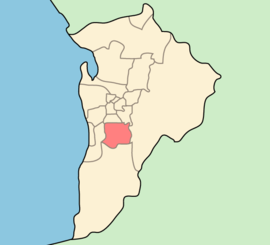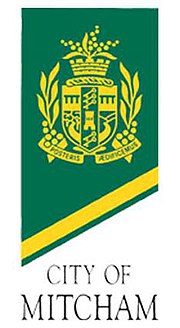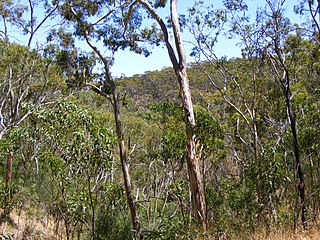
Belair National Park is a protected area in Belair, South Australia, 9 kilometres southeast of Adelaide city centre; it covers an area of 835 hectares. It was proclaimed in 1891 and was the first national park in South Australia, second in Australia and the tenth in the world. The national park lies within the Adelaide Hills and Mitcham council area, and forms part of a chain of protected areas located along the Adelaide Hills Face Zone. The national park is administered by the Department of Environment, Water and Natural Resources.

Adelaide Metro is the public transport system of the Adelaide area, around the capital city of South Australia. It is an intermodal system offering an integrated network of bus, tram, and train services throughout the metropolitan area. The network has an annual patronage of 79.9 million, of which 51 million journeys are by bus, 15.6 million by train, and 9.4 million by tram. The system has evolved heavily over the past fifteen years, and patronage increased dramatically during the 2014–15 period, a 5.5 percent increase on the 2013 figures due to electrification of frequented lines.

Belair is a suburb in the south eastern foothills of Adelaide, South Australia at the base of the Mount Lofty Ranges.
Torrens Park is a mainly residential large inner-southern suburb of Adelaide, incorporating some of the foothills and adjacent to the original "Mitcham Village". It was named after Sir Robert Richard Torrens, the instigator of the Torrens title system of land registration and transfer, who built a large home in the area which he named Torrens Park.
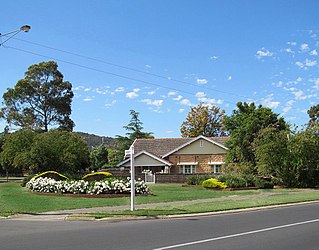
Colonel Light Gardens is a suburb located within the Australian City of Mitcham in the greater Adelaide region, approximately 7 km (4 mi) south of the Adelaide city centre. The area is 1.58 km2 (0.61 sq mi). Planned as a garden suburb, it is known for wide, tree-lined streets, presentable postwar bungalow homes, rounded street corners, and much manicured, well maintained open space.
Westbourne Park is an inner southern suburb of Adelaide, the State capital of South Australia. The suburb was named after Westbourne, a village in Sussex, England, and was laid out in 1881.

The Belair line is a suburban rail commuter route in the city of Adelaide, South Australia, that runs from the Adelaide station to Belair in the Adelaide Hills via the Adelaide-Wolseley line using diesel 3000/3100 class railcars. Prior to 1995, this part of Adelaide-Wolseley was a two-track broad gauge line. In 1995, Adelaide-Wolseley was converted to standard gauge meaning Adelaide to Belair is now effectively two separate single-track lines running in parallel: the Belair commuter line and the Adelaide-Wolseley standard gauge freight line.

Blackwood is a south-eastern suburb located in the foothills of Adelaide, South Australia. It is part of the local government area of the City of Mitcham.
Clapham, located approximately 8 kilometres (5.0 mi) south of the Adelaide city centre, is a primarily residential suburb situated within the City of Mitcham, incorporating some of the foothills. The suburb is named after Clapham in London, England. Neighbouring suburbs are Colonel Light Gardens, Panorama, Lynton, Torrens Park and Lower Mitcham.

Waite is a single-member electoral district for the South Australian House of Assembly. Named after Peter Waite, a 19th century entrepreneur and philanthropist, it covers 75.4 km² of suburbs and foothills in Adelaide's inner south-east, taking in the suburbs of Belair, Blackwood, Brown Hill Creek, Coromandel East, Coromandel Valley, Crafers West, Craigburn Farm, Eden Hills, Glenalta, Hawthorndene, Kingswood, Lynton, Mitcham, Netherby, Springfield, Torrens Park, Urrbrae as well as part of Upper Sturt.
Eden Hills is a south eastern suburb located in the foothills of Adelaide, South Australia. It is part of the local government area of the City of Mitcham.
Coromandel Valley is a semirural south-eastern suburb of Adelaide, South Australia. It straddles the City of Mitcham and the City of Onkaparinga council areas, with the Sturt River being the boundary between the two council areas.

Craigburn Farm is a suburb of Adelaide, South Australia, Australia. It is located about 17 km by road south of the city centre.
Glenalta is a suburb located in the south eastern Foothills of the Mount Lofty Ranges of Adelaide, South Australia. It is adjacent to Belair National Park.

The Hundred of Adelaide is a cadastral hundred in the city of Adelaide spanning all the inner suburbs south of River Torrens. It is one of the eleven hundreds of the County of Adelaide, and was one of the first hundreds to be proclaimed. Like the city it surrounds, the Hundred was named after Queen Adelaide, and was named by Governor Frederick Robe in 1846. It is 106 square miles (270 km2); close to but not exactly one hundred square miles as with most of the other hundreds. Its north boundary is the Torrens River and the Sturt River forms the south east boundary, with the hundred extending to the Adelaide foothills.
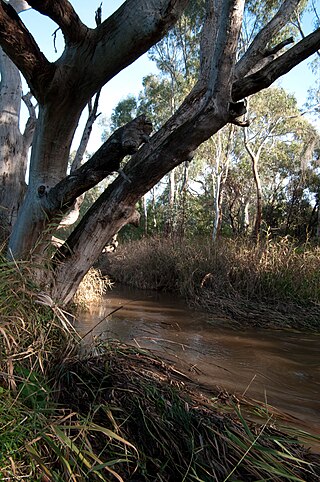
The Sturt River, also known as the Sturt Creek and Warri Parri (Warriparri) in the Kaurna language, is a river located in the Adelaide region of the Australian state of South Australia.
Mitcham was an electoral district of the House of Assembly in the Australian state of South Australia from 1938 to 1993. The district was based in the south-eastern suburbs of Adelaide.
Crafers West is a suburb of Adelaide in the Adelaide Hills Council. Located on Peramangk land, it was formally named in 1985 as a separate address from Crafers. Crafers West contains the headwaters of Brown Hill Creek and is dominated by steep terrain and native scrub. It is bounded by Mount Barker Road on the northeast and the Bridgewater railway line on the south. The Eagle Mountain Bike Park is in the north of the suburb. Popular tourist spots include Clealand Conservation Park, Mt Lofty Botanic Gardens, and Belair National Park Holiday Park.
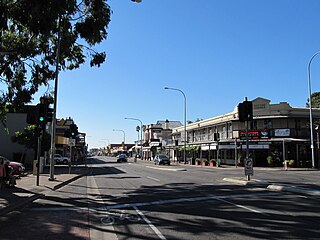
Unley Road is a road in the City of Unley, located south of the City of Adelaide, the capital of South Australia. It runs from South Terrace to Cross Road, where it becomes Belair Road. The road was named after the family name of the wife of Thomas Whistler, owner of land in Unley which was laid out around 1857.
